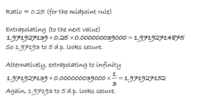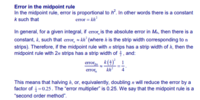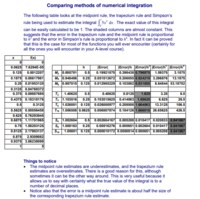You are using an out of date browser. It may not display this or other websites correctly.
You should upgrade or use an alternative browser.
You should upgrade or use an alternative browser.
Numerical methods, rates of convergence question
- Thread starter apple2357
- Start date
Dr.Peterson
Elite Member
- Joined
- Nov 12, 2017
- Messages
- 16,873
I can't claim to be familiar with what you are doing, but maybe that's good.
Can you quote the theorem or whatever that you are using, that includes this 0.25? That is, what ratio is this, and why do you expect it to be 0.25?
Can you quote the theorem or whatever that you are using, that includes this 0.25? That is, what ratio is this, and why do you expect it to be 0.25?
Dr.Peterson
Elite Member
- Joined
- Nov 12, 2017
- Messages
- 16,873
As I indicated, this is not something I know a lot about, so I am hoping someone else will be able to help.
But I have to say that the whole thing feels wrong to me. Specifically, the "second order" concept relates to provable bounds on the error, not necessarily to the actual error; and if the actual value could be estimated accurately by making the assumption they do, that would be taught as a standard method, which it is not to my knowledge.
The pages you attached do not quite apply to the differences that you have in your problem, but just to the actual error. But when I searched for information about the topic, and included the phrase "error multiplier", the first hit was apparently the very notes you are using, which suggests to me that this may be unique to them: https://mei.org.uk/files/conference07/B7.pdf (When something is only taught in one place, I worry.)
The next pages after what you showed do deal with differences, and evidently are the basis of your work. And their reasoning parallels what I had worked out.
But your actual question is not so much about the method, as about the very claim that the ratio of differences should be 0.25, when your data show about 0.0025. If I had more experience with these error differences, I would probably have more to say; but at this point, I just have to question whether the data you were given are described correctly. Are they really the midpoint approximations of some reasonable integral for n=16, 32, and 64?
But I have to say that the whole thing feels wrong to me. Specifically, the "second order" concept relates to provable bounds on the error, not necessarily to the actual error; and if the actual value could be estimated accurately by making the assumption they do, that would be taught as a standard method, which it is not to my knowledge.
The pages you attached do not quite apply to the differences that you have in your problem, but just to the actual error. But when I searched for information about the topic, and included the phrase "error multiplier", the first hit was apparently the very notes you are using, which suggests to me that this may be unique to them: https://mei.org.uk/files/conference07/B7.pdf (When something is only taught in one place, I worry.)
The next pages after what you showed do deal with differences, and evidently are the basis of your work. And their reasoning parallels what I had worked out.
But your actual question is not so much about the method, as about the very claim that the ratio of differences should be 0.25, when your data show about 0.0025. If I had more experience with these error differences, I would probably have more to say; but at this point, I just have to question whether the data you were given are described correctly. Are they really the midpoint approximations of some reasonable integral for n=16, 32, and 64?
Thanks Dr Peterson for spending time thinking about it. It was query that was passed to me from a student-teacher i have worked with and like you was not familiar enough with the topic. I might be able to dig up the original author of the document and explore further. If i am honest, it's not a topic that interests me enough at the moment and just wondered if others here were more familiar with it.





